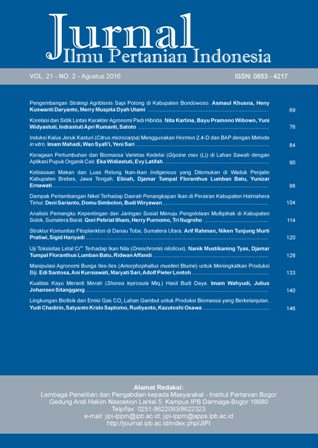Kualitas Kayu Meranti Merah (Shorea leprosula Miq.) Hasil Budi Daya
Abstract
Wood quality of five year-old of cultivated Red Meranti (Shorea leprosula Miq.) was studied in order to assure its proper utilization. The evaluation was conducted based on fiber dimension and physical properties of wood. Fiber dimension was measured through maceration specimen, while green moisture content, wood density, and specific gravity were measured following the modification of BS 373.75. Result shows that quality of Red Meranti wood studied was similar to that of naturally grown, except for its fibers which were shorter and thinner than those of naturally grown. It was found that wood quality of each tree was homogenous and even. Result also shows that average values of fiber length, cell wall thickness, moisture content in green condition, wood density and SG are 968.12 µm, 2.72 µm, 104.57%, 0.81 g/cm3, and 0.50, respectively. The wood is categorized as strength class of III, therefore, this Shorea leprosula wood is potential as raw material for plywood and furniture manufacturing, as well as for the 3-rd class of structural and other purposes. The trees unfortunately have not produce the mature wood yet, and the wood produced is not suitable for the highest quality of pulp and paper manufacturing.Downloads
References
Bowyer JL, Shmulsky R, Haygreen JG. 2003. Forest Products and Wood Science: An Introduction. Fourth Edition. Iowa (US): Iowa State University Press, Ames.
British Standard 373. 1957. Standard Test for Small Clear Specimen. England (GB): British Standard.
Cahyono TD, Wahyudi I, Priadi T, Febrianto F, Darmawan W, Bahtiar ET, Ohorella S. 2015. The quality of 8 and 10 years old samama wood (Anthocephalus macrophyllus). Journal of the Indian Academy of Wood Science. 12(1): 22-28. http://doi.org/bpq7
Makino K. 2013. Study on xylem maturation process relating to growth characteristics in several fast-growing tree species planted in Indonesia. [Thesis]. Utsunomiya (JP): Utsunomiya University. (Unpublished).
Martawijaya A, Kartasujana I, Kadir K, Prawira SA. 2005. Atlas Kayu Indonesia. Jilid 1. Bogor (ID): Badan Penelitian dan Pengembangan Kehutanan.
Muhran. 2013. Kualitas pertumbuhan dan karakteristik kayu jati (Tectona grandis L.f) hasil budi daya. [Skripsi]. Bogor (ID): Institut Pertanian Bogor.
Ogata K, Fujii T, Abe H, Baas P. 2008. Identification of the timbers of Southeast Asia and Western Pacific. PP. 360-363. Fujii T, Ogata K, Abe H, Noshiro S, Kagawa A (Editors). Japan (JP): Kaiseisha Press.
Panshin AJ, de Zeeuw C. 1980. Textbook of Wood Technology: Structure, Identification, Properties and Uses of The Commercial Woods of The United States and Canada. New York (US): McGraw-Hill Book Company.
Priasukmana S, Silitonga T. 1972. Dimensi Serat Beberapa Jenis Kayu Jawa Barat. Bogor (ID): LPHH.
PKKI-NI5. 1961. Peraturan Konstruksi Kayu Indonesia. Jakarta (ID): Yayasan Dana Normalisasi Indonesia.
Sinaga DKD. 2012. Evaluasi kualitas pertumbuhan dan karakteristik kayu jati (Tectona grandis L.f) unggul nusantara umur empat tahun. [Skripsi]. Bogor (ID): Institut Pertanian Bogor.
Tsoumis G. 1991. Science and Technology of Wood: Structure, properties and utilization. New York (US): Van Nostrand Reinhold.
Wahyudi I. 1995. Kualitas serat kayu Meranti Merah (Shorea spp.). Bogor (ID): Institut Pertanian Bogor.
Wahyudi I. 2000. Studies on the growth and wood qualities of tropical plantation species. [Dissertation]. Nagoya (JP): Nagoya University. (Unpublished).
Wahyudi I, Priadi T, Rahayu IS. 2014. Karakteristik dan sifat-sifat dasar kayu Jati Unggul umur 4 dan 5 tahun asal Jawa Barat. Jurnal Ilmu Pertanian Indonesia. 19(1): 50-56.
Zobel BJ, van JP Buijtenen. 1989. Wood Variation: Its causes and control. Springer-Verlag, Berlin, Heidelberg, New York, London, Paris, Tokyo.
This journal is published under the terms of the Creative Commons Attribution-NonCommercial 4.0 International License. Authors who publish with this journal agree to the following terms: Authors retain copyright and grant the journal right of first publication with the work simultaneously licensed under a Creative Commons Attribution-NonCommercial 4.0 International License. Attribution — You must give appropriate credit, provide a link to the license, and indicate if changes were made. You may do so in any reasonable manner, but not in any way that suggests the licensor endorses you or your use. NonCommercial — You may not use the material for commercial purposes.
























